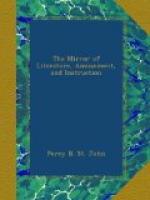Every one was anxious to bring to his recollection any little circumstance in which he had been concerned,—among others, a beautiful boat was brought to him as a present, in the building of which he himself had done “yeoman service.” He was delighted to see that this ancient piece of the workmanship of his own hands had been preserved with such care. He caused it to be put on board a ship bound for Petersburg, but she was unfortunately captured by the Swedes; and the boat is still kept in the arsenal of Stockholm.
With his old acquaintance, Kist, the blacksmith, he visited the smithy, which was so dirty that the gentleman of his suite who attended him was retreating, but Peter stopped him to blow the bellows and heat a piece of iron, which, when so done, he beat out with the great hammer. Kist was still but a journeyman blacksmith, and the Tzar out of compassion for his old acquaintance made him a handsome present.
[The Editor’s conclusion, or brief summary, is sketched as follows.]
The character of Peter the Great, as has been shown in the course of this memoir, was a strange compound of contradictions. Owing to the circumstances in which he was placed, and the determination to execute the plan he had conceived of remodelling the customs and institutions of his country, he had to maintain a constant struggle between his good and evil genius. Nothing was too great, nothing too little for his comprehensive mind. The noblest undertakings were mixed with the most farcical amusements; the most laudable institutions, for the benefit and improvement of his subjects, were followed by shaving their beards and docking their skirts;—kind-hearted, benevolent, and humane, he set no value on human life. Owing to these, and many other incongruities, his character has necessarily been represented in various points of view and in various colours by his biographers. Of him, however, it can scarcely be said, that
The evil which men do lives after them,
The good is oft interred with their bones.
With the exception of a few foreign writers, who have generally compiled their memoirs from polluted sources, the reverse of the aphorism may be applied to Peter. His memory, among his countrymen, who ought to be the best judges, and of whom he was at once the scourge and the benefactor, is held in the highest veneration, and is consecrated in their history and their public monuments to everlasting fame. The magnificent equestrian statue, erected by Catharine II.; the waxen figure of Peter in the museum of the Academy founded by himself; the dress, the sword, and the hat, which he wore at the battle of Pultowa, the last pierced through with a ball: the horse that he rode in that battle; the trousers, worsted stockings, shoes, and cap, which he wore at Zaandam, all in the same apartment; his two favourite dogs, his turning-lathe and tools, with specimens of his workmanship; the iron bar which he forged with his own hand at Olonitz; the Little Grandsire, so carefully preserved, as the first germ of the Russian navy; and the wooden hut in which he lived while superintending the first foundation of Petersburg;—these, and a thousand other tangible memorials, all preserved with the utmost care, speak in most intelligible language the opinion which the Russians hold of the Father of his Country.




